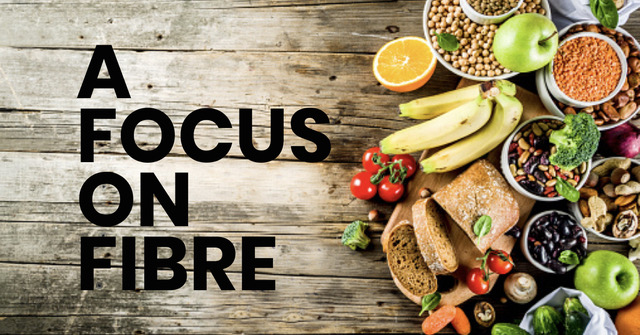
A focus on fibre
A focus on fibre: why it’s so important for our overall health
When it comes to health, we’re often being told what to cut out of our diets but there’s a key nutrient that most people don’t eat enough of: fibre.
The current government guidelines suggest adults should be consuming 30g of fibre daily (1), yet it’s suggested that on average we’re having only 18g (2).
A huge array of benefits of fibre have been uncovered in recent years, highlighting just how important meeting this recommendation is (3). The highly processed (thus low fibre) modern diet makes it harder than ever. Despite this, with a little extra care of your daily dietary habits you’ll soon find that hitting that 30g is easier than you think!
What is fibre?
Dietary fibre is the non-digestible carbohydrate found in plant foods (this includes fruits, vegetables, legumes, wholegrains, nuts and seeds). Fibre is made up of long chains of monosaccharides (single sugars) bound together in a way that our digestive enzymes are unable to break down. So, it passes through to the colon undigested. Here the fibre is either metabolised by our gut microbiome (the bacteria that live in our gut) or continues through the rest of the digestive tract relatively untouched. This is all dependent on the type of fibre, usually categorised into soluble and insoluble.
Soluble fibre:
This type of fibre tends to be the softer part of plant foods and dissolves in water to form a gel-like substance. This delays the emptying of the stomach, helping to slow down the rate that sugar enters the blood and making us feel fuller for longer, so may aid weight loss goals too. Some evidence also shows that soluble fibre can reduce cholesterol levels, which carries cardiovascular benefits (4).
A key distinction is that soluble fibre can be readily fermented by our gut microbiome, essentially using it as food. Our gut bacteria then produce a beneficial substance known as short-chain fatty acids. Many of the benefits of eating fibre are indirectly due to these fatty acids. They’ve been shown to help keep our gut barrier functioning properly, improve glucose and lipid (fat) metabolism as well as regulate our immune system (5). Their anti-inflammatory role may also help protect against some cancers (6).
Insoluble fibre:
Insoluble fibre tends to be much tougher, often part of the skin or outer shell of plant foods. This fibre however is relatively resistant to bacterial fermentation, so instead they contribute to slowing down digestion and “bulking” up our stools to allow it to pass through our gut more easily. This helps to prevent constipation, reducing the likelihood of haemorrhoids and diverticulitis (7). Hence this is the fibre known for keeping us regular!
Most plant foods contain a mix of both soluble and insoluble but it’s still important to eat a wide variety of foods to ensure both fibres are included in our daily diet.
Additionally, some of the bacteria in our gut help to absorb essential nutrients, while others can even produce them (such as B vitamins). So, maintaining a diverse range of bacteria in our gut by feeding them with plenty of fibre, in fact, supports our overall health. Plus, it goes without saying that eating lots of plant-based foods carries a whole host of nutrients aside to fibre.
Overview of the benefits of dietary fibre:
• Increases microbiome diversity
• Keeps our digestive system healthy and functioning well
• Supports our immune system
• Slows down digestion, reducing the blood sugar spike after eating
• Lowers blood cholesterol
• A healthy gut supports a healthy mind
• May aid weight loss by reducing appetite
• May reduce risk of heart disease, type 2 diabetes and some cancers
Tips to increase fibre intake
• Eat a diverse range of plant-based foods
Fruits, vegetables, legumes, nuts, seeds, and wholegrains all count! A big range of these is important in supporting the growth of a diverse gut microbiome.
• Choose wholegrain and brown options
When wholegrain bread or brown rice, for example, are processed into their white alternatives, a lot of the fibre is lost. In general, choosing the least processed form of foods is usually best to reap the most fibre.
• Choose whole foods over smoothies and juices
When plant foods are in their original whole form, the fibre remains intact. However, blending and juicing can breakdown the cell walls, reducing and/or removing the fibre content.
• Keep the skin on
For foods that have typically edible skins, such as apples, carrots and sweet potatoes, eating the skin provides a lot of insoluble fibre in particular.
• Add flaxseed or chia seeds to your diet daily
Both are fibre and micronutrient-rich powerhouses with minimal texture and taste so can be easily mixed into your meal.
REMINDER!
Increasing fibre intake too quickly if your gut is not accustomed to it may cause uncomfortable digestive issues. This is often because a by-product of the bacterial fermentation of fibre is gas, so it’s unlikely to be of concern.
If you do experience discomfort, such as excessive bloating and stomach pain, reduce fibre in your diet until symptoms dissipate and then start increasing your daily fibre gradually to 30g instead, allowing your microbiome time to adjust.
Also, ensure you’re drinking lots of water daily too! Throughout the digestion of fibre, water is pulled into the colon at various points supporting smooth transport.
Good sources of fibre
Hopefully we’ve convinced you to make sure you fill your plate with lots of fibre! Counting your daily grams of fibre is probably not necessary but do ensure that you’re eating a wide variety of plant-based foods every day (a good goal is 30 different ones per week!) and you’ll likely be hitting that sweet spot of 30g fibre. So, to conclude, we’ll leave you with some inspiration for some particularly high fibre foods…
• Fruit: apples, avocado, berries, citrus fruits, pears
• Vegetables: artichoke, beetroot, broccoli, carrots, potatoes
• Legumes: black beans, chickpeas, kidney beans, lentils
• Wholegrains: brown rice, oats, popcorn, wholewheat bread & pasta
• Nuts & seeds: almonds, chia seeds, flaxseed, sunflower seeds, walnuts
References
1) SACN (2015) Carbohydrates and Health. Public Health England.
2) Public Health England (2019) National Diet and Nutrition Survey [online] Available at: https://assets.publishing.service.gov.uk/government/uploads/system/uploads/attachment_data/file/943114/NDNS_UK_Y9-11_report.pdf
3) Barber, T. M., Kabisch, S., Pfeiffer, A., & Weickert, M. O. (2020). The Health Benefits of Dietary Fibre. Nutrients, 12(10), 3209.
4) Reynolds, A., Mann, J., Cummings, J., Winter, N., Mete, E., & Te Morenga, L. (2019). Carbohydrate quality and human health: a series of systematic reviews and meta-analyses. Lancet (London, England), 393(10170), 434–445.
5) Nogal, A., Valdes, A.M. and Menni, C. (2021). The role of short-chain fatty acids in the interplay between gut microbiota and diet in cardio-metabolic health. Gut Microbes, 13(1), pp.1–24.
6) Mirzaei, R., Afaghi, A., Babakhani, S., Sohrabi, M.R., Hosseini-Fard, S.R., Babolhavaeji, K., Khani Ali Akbari, S., Yousefimashouf, R. and Karampoor, S. (2021). Role of microbiota-derived short-chain fatty acids in cancer development and prevention. Biomedicine & Pharmacotherapy, 139, p.111619.
7) Gill, S. K., Rossi, M., Bajka, B., & Whelan, K. (2021). Dietary fibre in gastrointestinal health and disease. Nature reviews. Gastroenterology & hepatology, 18(2), 101–116.


